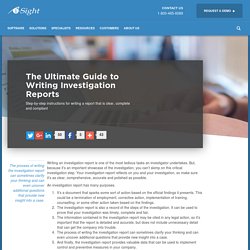

44 Investigation Interview Questions for the Complainant, Subject and Witnesses. Knowing what questions to ask in an investigation interview comes with experience.
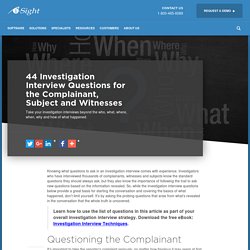
Investigators who have interviewed thousands of complainants, witnesses and subjects know the standard questions they should always ask, but they also know the importance of following the trail to ask new questions based on the information revealed. So, while the investigation interview questions below provide a great basis for starting the conversation and covering the basics of what happened, don’t limit yourself. It’s by asking the probing questions that arise from what’s revealed in the conversation that the whole truth is uncovered. Learn how to use the list of questions in this article as part of your overall investigation interview strategy.
Download the free eBook: Investigation Interview Techniques. Questioning the Complainant It’s important to take the reporter’s complaint seriously, no matter how frivolous it may seem at first glance. What happened? Learn more about questioning the complainant. 39 Tips for Conducting a Sexual Harassment Investigation. Sexual harassment allegations are among the most sensitive and tricky investigations that a company must conduct.
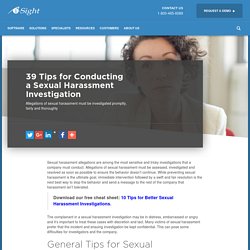
Allegations of sexual harassment must be assessed, investigated and resolved as soon as possible to ensure the behavior doesn’t continue. Ethics Hotline. Comply with International Regulations A well managed ethics hotline helps you uncover problems early, address them quickly and maintain a safe and ethical workplace.
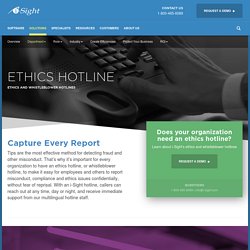
Ethics and compliance hotlines also help you comply with anti-corruption legislation, including: The Sarbanes-Oxley Act (SOX)Bill 198 (Canada)The Foreign Corrupt Practices Act (FCPA)The UK Bribery ActThe Corruption of Foreign Public Officials Act (CFPOA) How to Conduct a Workplace Investigation: Step-By-Step. Many HR, compliance and security investigators don’t receive targeted training on how to conduct a workplace investigation from start to finish.
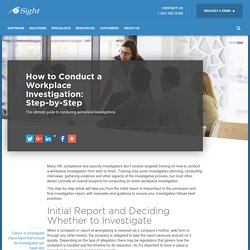
Training may cover investigation planning, conducting interviews, gathering evidence and other aspects of the investigative process, but most often doesn’t provide an overall blueprint for conducting an entire workplace investigation. This step-by-step article will take you from the initial report of misconduct to the conclusion and final investigation report, with examples and guidance to ensure your investigation follows best practices. Initial Report and Deciding Whether to Investigate Failure to investigate misconduct that should be investigated can have dire consequences for the company.
When a complaint or report of wrongdoing is received via a company’s hotline, web form or through any other means, the company is obligated to take the report seriously and act on it quickly. 101+ OSINT Resources for Investigators. When researching investigative subjects, the first stop for an investigator is usually the internet.
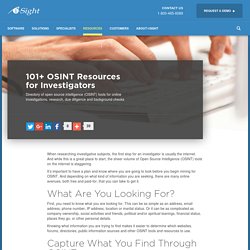
And while this is a great place to start, the sheer volume of Open Source Intelligence (OSINT) tools on the internet is staggering. It’s important to have a plan and know where you are going to look before you begin mining for OSINT. And depending on what kind of information you are seeking, there are many online avenues, both free and paid-for, that you can take to get it. What Are You Looking For? First, you need to know what you are looking for.
Knowing what information you are trying to find makes it easier to determine which websites, forums, directories, public information sources and other OSINT tools and resources to use. Capture What You Find Through OSINT The internet is fluid and what you find one day could be gone the next, so it’s a good idea to capture anything important immediately upon discovering it. Linguistic Lie Detection: A Valuable Investigation Tool. When assessing a witness statement for credibility, common sense goes a long way.
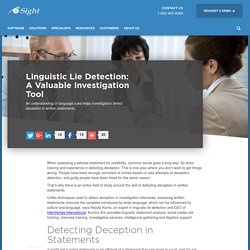
So does training and experience in detecting deception. This is one area where you don’t want to get things wrong. People have been wrongly convicted of crimes based on bad attempts at deception detection, and guilty people have been freed for the same reason. That’s why there is an entire field of study around the skill of detecting deception in written statements. Unlike techniques used to detect deception in investigation interviews, assessing written statements removes the variables introduced by body language, which can be influenced by culture and language, says Nejolla Korris, an expert in linguistic lie detection and CEO of InterVeritas International.
Detecting Deception in Statements Some of the basic things look for to detect deception in written statements are changes in pronouns, gaps in time, and evasive answers. 15 Types of Evidence and How to Use Them in Investigations. The ability to gather and analyze different types of evidence is one of the most important competencies for anyone who conducts investigations.
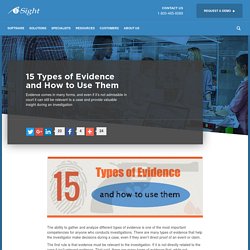
There are many types of evidence that help the investigator make decisions during a case, even if they aren’t direct proof of an event or claim. The first rule is that evidence must be relevant to the investigation. If it is not directly related to the case it isn’t relevant evidence. That said, there are many types of evidence that, while not admissible in court, can be valuable to an investigator trying to reach a conclusion in a workplace investigation or other non-criminal investigation. And even some evidence that is not admissible on its own may be admissible in conjunction with other types of evidence. 1. Writing Investigation Reports: The Ultimate Guide. The process of writing the investigation report can sometimes clarify your thinking and can even uncover additional questions that provide new insight into a case.
